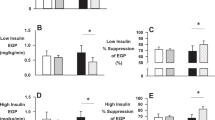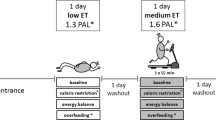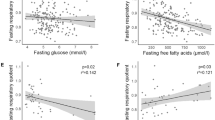Abstract
Objective:
To investigate whether the ‘overnight second-meal effect’ results in altered substrate oxidation during the postprandial period following breakfast and subsequent sub-maximal exercise in women.
Subjects/Methods:
Seven recreationally active women were recruited for the study. In each trial, participants were provided with their evening meal on day 1, which was composed of either high glycaemic index (HGI) or low glycaemic index (LGI) carbohydrates (CHO). On day 2, participants were provided with a standard HGI breakfast and then performed a 60 min run at 65% V̇O2 max 3 h later.
Results:
The incremental area under the curve (IAUC) for plasma glucose concentrations during the postprandial period following breakfast was greater in the HGI trial compared to the LGI trial (P<0.01). Similarly, the IAUC for serum insulin concentrations was greater in the HGI trial than the LGI trial (P<0.05). No differences in plasma free-fatty acids (FFA) or plasma glycerol concentrations were found between trials during the postprandial period. During subsequent exercise, there were no significant differences in substrate metabolism.
Conclusion:
The glycaemic index of an evening meal does not alter substrate oxidation at rest following breakfast or during subsequent submaximal exercise in women. This study provides further evidence for the overnight second-meal effect on glycaemic responses following a LGI mixed evening meal.
This is a preview of subscription content, access via your institution
Access options
Subscribe to this journal
Receive 12 print issues and online access
$259.00 per year
only $21.58 per issue
Buy this article
- Purchase on Springer Link
- Instant access to full article PDF
Prices may be subject to local taxes which are calculated during checkout







Similar content being viewed by others
References
Anderson GH, Woodend D (2003). Effect of glycemic carbohydrates on short-term satiety and food intake. Nutr Rev 61 (5 Pt 2), S17–S26.
Axelsen M, Arvidsson Lenner R, Lonnroth P, Smith U (1999). Breakfast glycaemic response in patients with type 2 diabetes: effects of bedtime dietary carbohydrates. Eur J Clin Nutr 53, 706–710.
Ball SD, Keller KR, Moyer-Mileur LJ, Ding YW, Donaldson D, Jackson WD (2003). Prolongation of satiety after low versus moderately high glycemic index meals in obese adolescents. Pediatrics 111, 488–494.
Basu R, Dalla Man C, Campioni M, Basu A, Klee G, Toffolo G et al. (2006). Effects of age and sex on postprandial glucose metabolism: differences in glucose turnover, insulin secretion, insulin action, and hepatic insulin extraction. Diabetes 55, 2001–2014.
Borg GA (1973). Perceived exertion: a note on ‘history’ and methods. Med Sci Sports 5, 90–93.
Cherbut C (2003). Motor effects of short-chain fatty acids and lactate in the gastrointestinal tract. Proc Nutr Soc 62, 95–99.
Dill DB, Costill DL (1974). Calculation of percentage changes in volumes of blood, plasma, and red cells in dehydration. J Appl Physiol 37, 247–248.
Foster-Powell K, Holt SH, Brand-Miller JC (2002). International table of glycemic index and glycemic load values. Am J Clin Nutr 76 (1), 5–56.
Frayn KN (1983). Calculation of substrate oxidation rates in vivo from gaseous exchange. J Appl Physiol 55, 628–634.
Granfeldt Y, Wu X, Bjorck I (2006). Determination of glycaemic index; some methodological aspects related to the analysis of carbohydrate load and characteristics of the previous evening meal. Eur J Clin Nutr 60, 104–112.
Horton TJ, Grunwald GK, Lavely J, Donahoo WT (2006). Glucose kinetics differ between women and men, during and after exercise. J Appl Physiol 100, 1883–1894.
Horton TJ, Pagliassotti MJ, Hobbs K, Hill JO (1998). Fuel metabolism in men and women during and after long-duration exercise. J Appl Physiol 85, 1823–1832.
Jenkins DJ, Wolever TM, Taylor RH, Griffiths C, Krzeminska K, Lawrie JA et al. (1982). Slow release dietary carbohydrate improves second meal tolerance. Am J Clin Nutr 35, 1339–1346.
Knechtle B, Muller G, Willmann F, Kotteck K, Eser P, Knecht H (2004). Fat oxidation in men and women endurance athletes in running and cycling. Int J Sports Med 25, 38–44.
Liljeberg H, Bjorck I (2000). Effects of a low-glycaemic index spaghetti meal on glucose tolerance and lipaemia at a subsequent meal in healthy subjects. Eur J Clin Nutr 54, 24–28.
Liljeberg HG, Akerberg AK, Bjorck IM (1999). Effect of the glycemic index and content of indigestible carbohydrates of cereal-based breakfast meals on glucose tolerance at lunch in healthy subjects. Am J Clin Nutr 69, 647–655.
Ludwig DS (2002). The glycemic index: physiological mechanisms relating to obesity, diabetes, and cardiovascular disease. JAMA 287, 2414–2423.
Ludwig DS, Majzoub JA, Al-Zahrani A, Dallal GE, Blanco I, Roberts SB (1999). High glycemic index foods, overeating, and obesity. Pediatrics 103, E26.
Mittendorfer B, Horowitz JF, Klein S (2002). Effect of gender on lipid kinetics during endurance exercise of moderate intensity in untrained subjects. Am J Physiol Endocrinol Metab 283, E58–E65.
Nilsson A, Granfeldt Y, Ostman E, Preston T, Bjorck I (2006). Effects of GI and content of indigestible carbohydrates of cereal-based evening meals on glucose tolerance at a subsequent standardised breakfast. Eur J Clin Nutr 60, 1092–1099.
Roepstorff C, Steffensen CH, Madsen M, Stallknecht B, Kanstrup IL, Richter EA et al. (2002). Gender differences in substrate utilization during submaximal exercise in endurance-trained subjects. Am J Physiol Endocrinol Metab 282, E435–E447.
Rumessen JJ (1992). Hydrogen and methane breath tests for evaluation of resistant carbohydrates. Eur J Clin Nutr 46 (Suppl 2), S77–S90.
Shirreffs SM, Maughan RJ (1998). Urine osmolality and conductivity as indices of hydration status in athletes in the heat. Med Sci Sports Exerc 30, 1598–1602.
Steffensen CH, Roepstorff C, Madsen M, Kiens B (2002). Myocellular triacylglycerol breakdown in females but not in males during exercise. Am J Physiol Endocrinol Metab 282, E634–E642.
Stevenson E, Williams C, Mash L, Phillips B, Nute M (2006). Influence of high-carbohydrate mixed meals with different glycemic indexes on substrate utilization during subsequent exercise in women. Am J Clin Nutr 84, 354–360.
Stevenson E, Williams C, Nute M (2005). The influence of the glycaemic index of breakfast and lunch on substrate utilisation during the postprandial periods and subsequent exercise. Br J Nutr 93, 885–893.
Stevenson E, Williams C, Nute M, Swaile P, Tsui M (2005). The effect of the glycemic index of an evening meal on the metabolic responses to a standard high glycemic index breakfast and subsequent exercise in men. Int J Sport Nutr Exerc Metab 15, 308–322.
Tarnopolsky MA, Atkinson SA, Phillips SM, MacDougall JD (1995). Carbohydrate loading and metabolism during exercise in men and women. J Appl Physiol 78, 1360–1368.
Thomas DE, Brotherhood JR, Brand JC (1991). Carbohydrate feeding before exercise: effect of glycemic index. Int J Sports Med 12, 180–186.
Thorburn A, Muir J, Proietto J (1993). Carbohydrate fermentation decreases hepatic glucose output in healthy subjects. Metabolism 42, 780–785.
Venables MC, Achten J, Jeukendrup AE (2005). Determinants of fat oxidation during exercise in healthy men and women: a cross-sectional study. J Appl Physiol 98, 160–167.
Warren JM, Henry CJ, Simonite V (2003). Low glycemic index breakfasts and reduced food intake in preadolescent children. Pediatrics 112, e414.
Wee SL, Williams C, Gray S, Horabin J (1999). Influence of high and low glycemic index meals on endurance running capacity. Med Sci Sports Exerc 31, 393–399.
Williams C, Nute MG, Broadbank L, Vinall S (1990). Influence of fluid intake on endurance running performance. A comparison between water, glucose and fructose solutions. Eur J Appl Physiol Occup Physiol 60, 112–119.
Wolever TM, Jenkins DJ (1986). The use of glycemic index in predicting the blood glucose response to mixed meals. Am J Clin Nutr 43, 167–172.
Wolever TM, Jenkins DJ, Ocana AM, Rao VA, Collier GR (1988). Second-meal effect: low-glycemic-index foods eaten at dinner improve subsequent breakfast glycemic response. Am J Clin Nutr 48, 1041–1047.
Wolever TM, Spadafora P, Eshuis H (1991). Interaction between colonic acetate and propionate in humans. Am J Clin Nutr 53, 681–687.
Wu CL, Nicholas C, Williams C, Took A, Hardy L (2003). The influence of high-carbohydrate meals with different glycaemic indices on substrate utilisation during subsequent exercise. Br J Nutr 90, 1049–1056.
Acknowledgements
We thank the women who participated in this study. EJS produced the original study design, performed the laboratory investigations and biochemical analysis, undertook the statistical data analysis, and wrote the first draft of the article. MLN, LH and OW assisted with the laboratory investigations and biochemical analysis. CW supervised the data collection, contributed to the data interpretation and revised the article. None of the authors had any conflicts of interest.
Author information
Authors and Affiliations
Corresponding author
Rights and permissions
About this article
Cite this article
Stevenson, E., Williams, C., Nute, M. et al. Influence of the glycaemic index of an evening meal on substrate oxidation following breakfast and during exercise the next day in healthy women. Eur J Clin Nutr 62, 608–616 (2008). https://doi.org/10.1038/sj.ejcn.1602759
Received:
Revised:
Accepted:
Published:
Issue Date:
DOI: https://doi.org/10.1038/sj.ejcn.1602759
Keywords
This article is cited by
-
Postprandial blood glucose response: does the glycaemic index (GI) value matter even in the low GI range?
Nutrition & Diabetes (2020)
-
Glycaemic index of meals affects appetite sensation but not energy balance in active males
European Journal of Nutrition (2014)
-
Adaptive metabolic response to 4 weeks of sugar-sweetened beverage consumption in healthy, lightly active individuals and chronic high glucose availability in primary human myotubes
European Journal of Nutrition (2013)
-
A study of Hassawi rice (Oryza sativa L.) in terms of its carbohydrate hydrolysis (in vitro) and glycaemic and insulinaemic indices (in vivo)
European Journal of Clinical Nutrition (2011)



